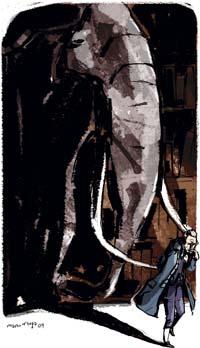Jefferson Monsters

It was time to end that baseless myth. Yes, the mammoth was a monster for that. Thomas Jefferson was convinced.
Twenty years earlier came an unfounded myth. The culprit was a great French naturalist: Georges Louis Leclerc, Count of Buffon. In 1761 Buffon wrote that the creatures of the New World were less numerous than those of the Old World. According to him, the lands of that continent were almost sterile and the animals were smaller and weaker than those of the Old World, since the harmful vapors of the corrupt swamps and the sunless forests weakened them. Nor did the natives have virility: "They have no burrs, hair on the body, or passion for the female. Their sexual organs are also small and weak."
For Buffon, the American fauna was degenerate. And that thought had many followers. Jefferson admired the work of the French naturalist, but considered his continent degenerate... I could not take it. And he wanted to face these arguments in his book Notes on the State of Virginia, published in 1781.
Jefferson compared the weights of several European and American animals to show that those in America were no poorer. And if buffalo and bears were not enough, those huge mammoths would have silenced anything.
In recent years the bones of that giant animal were being discovered. At first it became known as American incognitum and was then identified as mammoth. Grieved by the idea of degeneration, American naturalists were so excited to claim the greatness and brutality of that creature that they made six times bigger and put some terrible claws on it. There were fangs that looked down like a saber-toothed tiger. This giant elephant was credited with the vitality and brutality of a tiger.
Jefferson, like many other contemporaries, was convinced that he was a carnivorous mammoth. And it was also the "greatest being on earth." Buffon's ideas were powerless before a giant carnivorous elephant. But he did not retreat. On the contrary, it reduced the American mammoth to the level of normal elephants or hippos, and even looked like a missing animal, which the Frenchman used in favor of his theory.
Jefferson was clear that he was not a normal elephant or a hippo. On the contrary, I thought it was like the Siberian mammoths, perhaps the same species. And I wasn't so sure it had disappeared, maybe those animals could be alive in some unexplored area of America. The appearance of these monsters in indigenous legends reinforces Jefferson's hope. When included in the Notes on the State of Virginia animal list, write: "You can ask me why I put the ghost in as if it still existed. And I say: Why leave it out as if it did not exist?"
In the spring of 1796, Jefferson was fascinated by the bones of another animal. Mine workers discovered the bones of one leg and huge claws. When Jefferson saw them, he was fascinated. They looked like an animal from the family of lions, tigers and panthers, but that beast had to be much bigger. By the size of the claws he calculated that it would be three times greater than African lions. It was called megalonyx (large claw). Jefferson had a second American monster.
In March 1797 he presented the beast Megalonyx at a conference in Philadelphia. And, like the ghost, he said he could still be alive: "Inside our continent there are plenty of places for elephants and lions that can live in this climate, and also for mammoth and Megalonyx. The ignorance we have of the west and northwest of our country makes it impossible to say what is not there."
But before giving that lecture, in a number of the English magazine Monthly Magazine, he saw an illustration of the fossil of a giant finger animal. It was discovered in Paraguay and assembled in the Royal Cabinet of Natural History of Madrid. The illustration was based on a 1796 article by the new paleontology star Georges Cuvier.
It was said with Cuvier that a tooth or a small piece of jaw had enough to meet an animal, and often also to give gender and species. Prior to the Paraguay fossil article, he wrote another of great prestige, about living elephant species and fossils. In this article, he stated that Asian and African elephants belonged to different species, and that mammoth fossils belonged to another missing species; and those that appeared in Italy, which were considered bones of Hanibal elephants. And later, when he had the opportunity to study the bones of the American mammoth, it was he who formally described it. It was different from European ghosts and was called mastodonte. And no, it was not carnivorous.
In the article on the fossil of Paraguay, Cuvier clearly saw that the skeleton corresponded to a lazy animal from South America. This animal was called Megatherium.
Seeing that article, Jefferson understood that his giant lion could also be a lazy one. Thus, before publishing his work on Megalonyx, he had to add a note in which he recognized that these claws could be of a Megatherium.
Cuvier, in his work on weeds published in 1804, concluded that the predator of Jefferson did not belong to the same species as the Megatherium, maintaining the name of Jefferson. Almost 20 years later, another French anatomist formed his name: Megalonyx jeffersonii.






